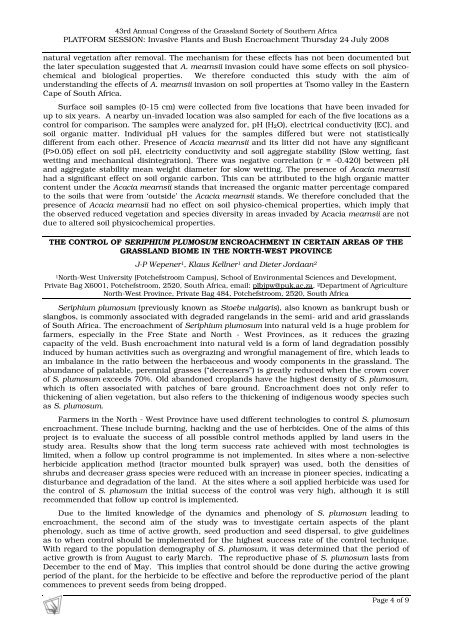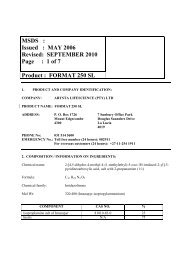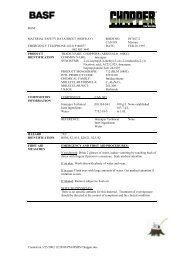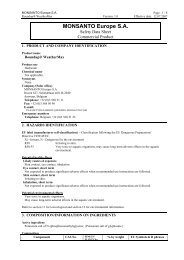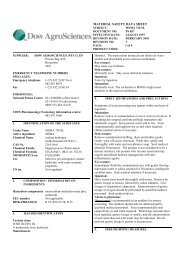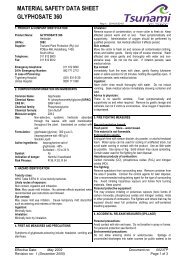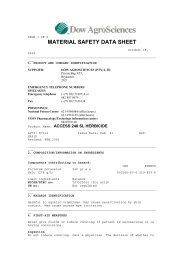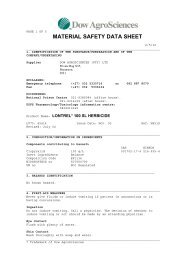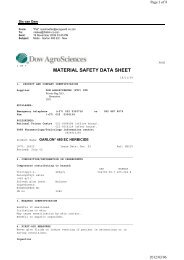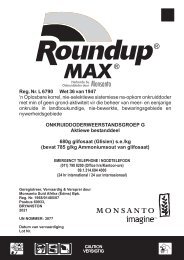Invasive Plants and Bush Encroachment
Invasive Plants and Bush Encroachment
Invasive Plants and Bush Encroachment
You also want an ePaper? Increase the reach of your titles
YUMPU automatically turns print PDFs into web optimized ePapers that Google loves.
43rd Annual Congress of the Grassl<strong>and</strong> Society of Southern Africa<br />
PLATFORM SESSION: <strong>Invasive</strong> <strong>Plants</strong> <strong>and</strong> <strong>Bush</strong> <strong>Encroachment</strong> Thursday 24 July 2008<br />
natural vegetation after removal. The mechanism for these effects has not been documented but<br />
the later speculation suggested that A. mearnsii invasion could have some effects on soil physicochemical<br />
<strong>and</strong> biological properties. We therefore conducted this study with the aim of<br />
underst<strong>and</strong>ing the effects of A. mearnsii invasion on soil properties at Tsomo valley in the Eastern<br />
Cape of South Africa.<br />
Surface soil samples (0-15 cm) were collected from five locations that have been invaded for<br />
up to six years. A nearby un-invaded location was also sampled for each of the five locations as a<br />
control for comparison. The samples were analyzed for, pH (H 2O), electrical conductivity (EC), <strong>and</strong><br />
soil organic matter. Individual pH values for the samples differed but were not statistically<br />
different from each other. Presence of Acacia mearnsii <strong>and</strong> its litter did not have any significant<br />
(P>0.05) effect on soil pH, electricity conductivity <strong>and</strong> soil aggregate stability (Slow wetting, fast<br />
wetting <strong>and</strong> mechanical disintegration). There was negative correlation (r = -0.420) between pH<br />
<strong>and</strong> aggregate stability mean weight diameter for slow wetting. The presence of Acacia mearnsii<br />
had a significant effect on soil organic carbon. This can be attributed to the high organic matter<br />
content under the Acacia mearnsii st<strong>and</strong>s that increased the organic matter percentage compared<br />
to the soils that were from ‘outside’ the Acacia mearnsii st<strong>and</strong>s. We therefore concluded that the<br />
presence of Acacia mearnsii had no effect on soil physico-chemical properties, which imply that<br />
the observed reduced vegetation <strong>and</strong> species diversity in areas invaded by Acacia mearnsii are not<br />
due to altered soil physicochemical properties.<br />
THE CONTROL OF SERIPHIUM PLUMOSUM ENCROACHMENT IN CERTAIN AREAS OF THE<br />
GRASSLAND BIOME IN THE NORTH-WEST PROVINCE<br />
J-P Wepener 1 , Klaus Kellner 1 <strong>and</strong> Dieter Jordaan 2<br />
1North-West University (Potchefstroom Campus), School of Environmental Sciences <strong>and</strong> Development,<br />
Private Bag X6001, Potchefstroom, 2520, South Africa, email: plbjpw@puk.ac.za, 2 Department of Agriculture<br />
North-West Province, Private Bag 484, Potchefstroom, 2520, South Africa<br />
Seriphium plumosum (previously known as Stoebe vulgaris), also known as bankrupt bush or<br />
slangbos, is commonly associated with degraded rangel<strong>and</strong>s in the semi- arid <strong>and</strong> arid grassl<strong>and</strong>s<br />
of South Africa. The encroachment of Seriphium plumosum into natural veld is a huge problem for<br />
farmers, especially in the Free State <strong>and</strong> North - West Provinces, as it reduces the grazing<br />
capacity of the veld. <strong>Bush</strong> encroachment into natural veld is a form of l<strong>and</strong> degradation possibly<br />
induced by human activities such as overgrazing <strong>and</strong> wrongful management of fire, which leads to<br />
an imbalance in the ratio between the herbaceous <strong>and</strong> woody components in the grassl<strong>and</strong>. The<br />
abundance of palatable, perennial grasses (“decreasers”) is greatly reduced when the crown cover<br />
of S. plumosum exceeds 70%. Old ab<strong>and</strong>oned cropl<strong>and</strong>s have the highest density of S. plumosum,<br />
which is often associated with patches of bare ground. <strong>Encroachment</strong> does not only refer to<br />
thickening of alien vegetation, but also refers to the thickening of indigenous woody species such<br />
as S. plumosum.<br />
Farmers in the North - West Province have used different technologies to control S. plumosum<br />
encroachment. These include burning, hacking <strong>and</strong> the use of herbicides. One of the aims of this<br />
project is to evaluate the success of all possible control methods applied by l<strong>and</strong> users in the<br />
study area. Results show that the long term success rate achieved with most technologies is<br />
limited, when a follow up control programme is not implemented. In sites where a non-selective<br />
herbicide application method (tractor mounted bulk sprayer) was used, both the densities of<br />
shrubs <strong>and</strong> decreaser grass species were reduced with an increase in pioneer species, indicating a<br />
disturbance <strong>and</strong> degradation of the l<strong>and</strong>. At the sites where a soil applied herbicide was used for<br />
the control of S. plumosum the initial success of the control was very high, although it is still<br />
recommended that follow up control is implemented.<br />
Due to the limited knowledge of the dynamics <strong>and</strong> phenology of S. plumosum leading to<br />
encroachment, the second aim of the study was to investigate certain aspects of the plant<br />
phenology, such as time of active growth, seed production <strong>and</strong> seed dispersal, to give guidelines<br />
as to when control should be implemented for the highest success rate of the control technique.<br />
With regard to the population demography of S. plumosum, it was determined that the period of<br />
active growth is from August to early March. The reproductive phase of S. plumosum lasts from<br />
December to the end of May. This implies that control should be done during the active growing<br />
period of the plant, for the herbicide to be effective <strong>and</strong> before the reproductive period of the plant<br />
commences to prevent seeds from being dropped.<br />
Page 4 of 9


